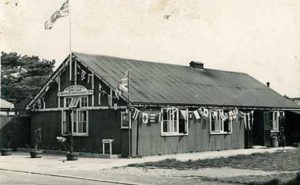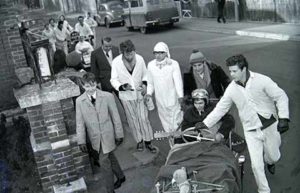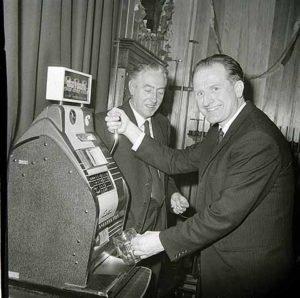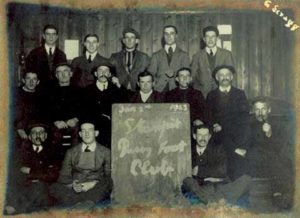The Mudeford Club at 90
Ian Kennedy on the transition from drinking den to heart of the community
Published in May ’18

The original building of the Mudeford & District Mens Club & Institute (Christchurch) Ltd as opened in 1928
All things must change but change doesn’t always happen overnight. Just ask the members of the former Mudeford Men’s Club as it celebrates its ninetieth year. ‘The club has gone through many changes,’ says the president of thirteen years, Laurie Wilkinson. ‘Looking back, some of the members genuinely thought we were going to ruin their club by admitting ladies as members and ending the men-only second bar. As it turned out, if anything we have gained members as couples join together.’
The Mudeford Club continues to thrive at the heart of its community. In conjunction with Stanpit village hall, which sits on the other side of the road, it gives the village a focal point for social events. ‘What’s happened is that village pubs have had to go over to food,’ says club treasurer Paul Rogers. ‘Every village pub used to have a darts team, but family diners don’t want darts going on around them, so that’s a service we can provide and we have several men’s, ladies’ and mixed teams in the local Monday, Thursday and Friday darts leagues.’

Bed race in the 1960s. Members would push beds around Mudeford on Boxing Day collecting money for charity before returning to the club for refreshments and the annual auction
The Mudeford Club’s history can be traced back to 27 February 1887 and the opening of the Mission Room in Stanpit on land and with money provided by General and Mrs Maberley. In time that became Stanpit Village Room and, again funded by the Maberleys, an annexe was built in which local fishermen could meet during winter. Members paid two shillings a quarter.
By the 1920s, the Meeting Room was being run as an unlicensed drinking den named the Pussyfoot Club, either after William E ‘Pussyfoot’ Johnson, the man charged with enforcing Prohibition in the United States, or because locals would slip their shoes off and pad quietly home so as not to draw attention to their boozing. Either way, in the face of local resistance to the idea, funds were raised for Mudeford and District Working Men’s Club to be built by members on land opposite, where Alfred Edgell sold his allotment for £60. The club’s first president (also chairman and treasurer), Rev. W Wynne-Hall was appointed in 1927 and on 31 March 1928 the official opening took place presided over by Captain Harold Wiggins in front of an audience of male and female subscribers and supporters. One, a Mrs Wormold, donated a collection of animal heads to hang on the walls of the new club, as well as several books to form the nucleus of a library.

In 1960 members voted unanimously against installing a fruit machine then, in the traditional Mudeford Club style, a year later changed their minds
In his opening remarks, Rev. Wynne-Hall addressed the issue of drink: ‘Let it not be said that any member of this club will so far forget himself as to bring discredit on it. I don’t mind any man having his glass of beer. I am an Englishman, born in a free country, and free I will remain until the end of my days. On the other hand I shall be ruthless in the suppression of disorder by any person who is deficient in self-respect of his neighbours….’
The club thrived as a bastion of male communion, but always with a weather eye on the village at large. The first children’s Christmas party was held in 1936 and during the War it opened as a rest centre for those whose homes had been bombed. After the War membership blossomed and in 1947, not only did the president’s casting vote result in the acquisition of a wireless set, but the club was granted permission to sell food, establishing a menu of bread and cheese that remained largely unchanged for twenty years.
A decade later, on 10 November 1957, the first meeting was held to discuss the admission of female members in an effort to shore up club finances. Although it was thought that the proposal had been passed, another vote held in February 1959 overturned it and women were again barred – until a further vote in April that year permitted the trial admission of women (but not as members) on Saturdays and Sundays during the summer months. With takings up, it was duly voted to make the move permanent.

The notorious Pussyfoot Club photographed on 2 January 1923 – did they take their shoes off and ‘pussyfoot’ home, or were they named in honour of the enforcer of US Prohibition?
The Mudeford Club has always contributed enormously to village life, fulfilling local needs as it is able to. Today it has become a de facto clubhouse for the local cricket teams, whose players gather outside before away games and always return to the bar after matches. ‘It’s the same with the football teams,’ says Laurie. ‘We welcome them in and a lot of the younger lads are members now. They come in with their wives and girlfriends and on Saturday afternoons we admit children as well. If there’s live sport on TV we have big screens, so major events like the cup finals, or the World Cup, or if AFC Bournemouth have a big game become family occasions at the club.
In the 1960s the club welcomed its first fruit machine – a year after members initially voted unanimously against it – and Sunday bingo appeared along with a new building alongside the original ‘Green Hut’. The dawn of a new decade brought the first annual dinner dance and the Pussyfoot seafood dinner to commemorate the founders. In 1974, members voted to introduce soft toilet paper to the ladies’ loo!
The annual marrow competition dates back to 1982 and in its diamond jubilee year the club donated £5400 to Portfield School for a soft room. In 1990 a CD player arrived, then in November 1992 a £100,000 extension opened, followed by a new kitchen in 1995 and by the end of the decade, both bars had been refurbished and air conditioning installed.
And then it happened. The 21st century was barely a year old and lady affiliate members were finally admitted. Full membership duly followed and with the introduction of high-speed wi-fi, a club website, multi-channel television, a large screen projector and the demise of the men-only bar confirmed, the Mudeford Club is fit to face the future.

